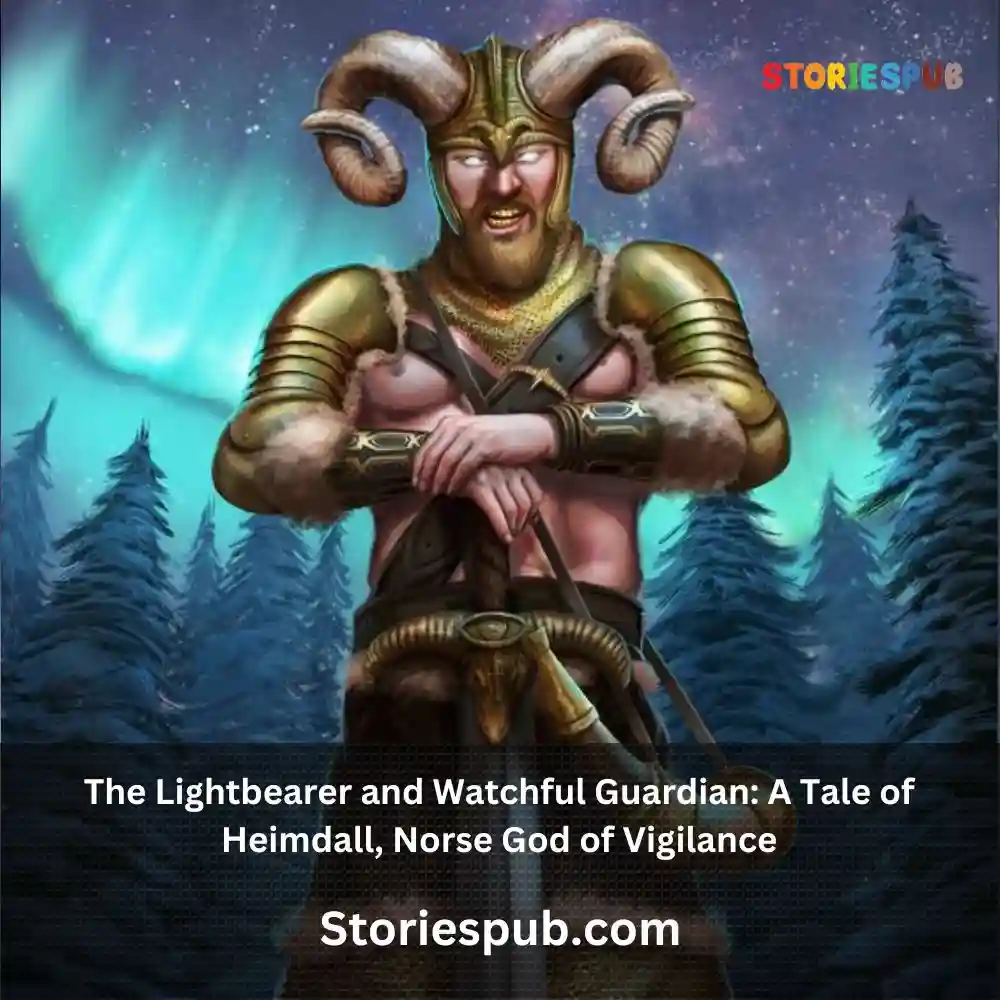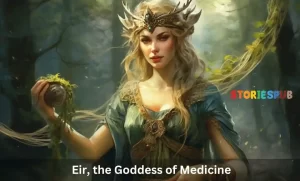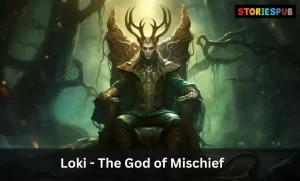The Lightbearer and Watchful Guardian: A Tale of Heimdall, Norse God of Vigilance

Image credit : Pinterest
Introduction
Norse mythology is rich with fascinating characters and stories, filled with gods, goddesses, giants, dwarves, and other mythical creatures. These tales are often violent and epic in scale, chronicling the struggles of the Norse gods as they face off against various foes.
One of the most intriguing figures in this pantheon is Heimdall, the god of light and watchfulness. Known for his ability to see great distances and hear even the faintest sounds, Heimdall was charged with guarding the Bifrost Bridge – the rainbow bridge that connected Asgard (the home of the gods) to Midgard (the world of humans).
Brief Overview of Norse Mythology
Before diving into Heimdall’s story, it’s important to have a basic understanding of Norse mythology as a whole. The religion originated in Scandinavia during the Viking Age (around 800-1100 CE) and was practiced by many communities throughout Northern Europe.
The Norse believed in a complex system of gods and goddesses who were responsible for different aspects of life on Earth. For example, Odin was considered to be the Allfather – ruler of all gods – while Thor was associated with thunderstorms and war.
Norse mythology also featured several realms beyond Midgard and Asgard. These included Jotunheim (home to giants), Helheim (where those who died dishonorably went after death), and Valhalla (the hall where warriors who died bravely in battle went after death).
Introduction to Heimdall: The God of Light and Watchfulness
Heimdall is one of many fascinating characters in Norse mythology. According to legend, he was born from nine mothers who were all sisters – a unique origin story that set him apart from other gods.
Heimdall is often depicted as having golden hair and teeth made from pure gold. He is known for his incredible senses, which allow him to see and hear things that others cannot.
He is also proficient in several forms of combat, including archery and sword fighting. However, Heimdall’s most important role was as the guardian of the Bifrost Bridge.
This task was crucial because it prevented giants and other enemies of the gods from crossing over into Asgard. In this way, he played a vital role in maintaining the safety and security of the divine realm.
Despite his formidable abilities as a warrior and a guardian, Heimdall was also known for his wisdom and insight. His keen senses allowed him to see things that others could not – both literally and metaphorically – making him an important advisor to Odin and other leaders in Asgard.
Heimdall’s Origins
Birth and Parentage
In Norse mythology, Heimdall was considered as one of the Aesir Gods. He is believed to have been born from nine giant women who offered him protection and great strength. His father was Odin, the Allfather, who had sent himself to Earth in disguise as a mortal.
According to legend, Heimdall’s birth was marked by lightning and thunder, with his eyes glowing with an otherworldly light. Heimdall was raised in Asgard, home of the gods and goddesses.
His upbringing was unique compared to other gods because he spent his childhood among humans rather than only with his divine kin. This gave him a broad perspective on the world that would later serve him well when he became a sentinel for all creation.
Childhood and Early Life
As a young god, Heimdall showed remarkable abilities such as exceptional sight, hearing, and speed. His hearing was so sharp that he could hear the grass grow in far-off fields or detect whispers of betrayal from miles away. His eyesight could penetrate deep into darkness or pierce through fog or mist without any difficulty.
He also displayed an uncanny ability to move quickly, which made him a swift runner on land or water. One of his famous feats during childhood involved racing against Loki – another god in Norse mythology – across great distances using their unique abilities.
Acquisition of Gjallarhorn and Other Notable Possessions
One of Heimdall’s most prized possessions is Gjallarhorn – a powerful horn that can be heard across all the nine worlds of Norse mythology. The horn is so loud that it can reach far-off places even if they are not visible from where it is blown.
Not only did Heimdall possess this powerful artifact, but he also acquired other important items such as his sword, Hofund, and a gold-clad horse called Gulltoppr. These items made him a formidable opponent in any battle or conflict he faced.
In addition to these items, Heimdall was also gifted with the ability to make his way through the universe using the Bifrost bridge – a rainbow-colored bridge that connected Asgard and Midgard. This ability allowed him to travel anywhere in the nine worlds with ease, making him an essential figure in Norse mythology.
Overall, Heimdall’s origins and early life are significant aspects of his story as they set the stage for his future role as guardian of Bifrost Bridge. His unique abilities and prized possessions helped establish him as one of the most powerful gods in Norse mythology.
The Watcher on the Rainbow Bridge
Description of Bifrost Bridge and its significance in Norse mythology
In Norse mythology, Bifrost Bridge is a mythical rainbow bridge that connects Asgard, the home of the gods, to Midgard, the realm of humans. It is said to be made of fire and water, and is guarded by Heimdall.
The bridge has great significance in Norse mythology because it connects two realms that are otherwise separated from each other. It also acts as a barrier that prevents hostile beings from crossing over into Asgard.
Heimdall’s duties as guardian, including his heightened senses and ability to detect threats from afar
Heimdall’s role as the guardian of Bifrost Bridge is vital for maintaining order in the Norse universe. He is responsible for alerting the gods when danger approaches and preventing any hostile beings from crossing over into Asgard. He has heightened senses that allow him to hear sounds from far away and see things with great clarity even in complete darkness.
He can detect any threat before it crosses over into Asgard. One example of Heimdall’s abilities was during Ragnarok – The end times when he could see further than anyone else and sounding his horn Gjallarhorn to warn Odin on top of his hall Valaskjalf about an imminent doom headed towards them.
Examples of times when Heimdall had to defend the bridge, including battles with giants and Loki
Throughout Norse mythology there are several examples where Heimdall had to defend Bifrost Bridge against invaders who wanted to enter Asgard. One notable battle was when Loki tried to cross over into Asgard disguised as a giant. However, he was stopped at Bifrost Bridge by Heimdall who saw through his disguise using his sharp senses.
Another example was during a battle with the frost giants, where Heimdall stood his ground and prevented them from crossing over into Asgard. He used his horn Gjallarhorn to call upon the other gods for help, signaling that an attack was imminent.
Together with the other gods, they were able to repel the frost giants and maintain order in Asgard. Heimdall’s role as the guardian of Bifrost Bridge is essential in Norse mythology.
His heightened senses, alertness, and bravery make him one of the most significant gods in Norse mythology. His duty to protect Asgard from any invading forces is a testament to his loyalty and courage.
Relationships with Other Gods
Heimdall, the god of light and watchfulness, is not just a solitary figure in Norse mythology. He has numerous relationships with other gods, some of which are quite significant. In this section, we will explore Heimdall’s relationships with Odin, Thor, and Freyja.
Relationship with Odin, the Allfather
Heimdall and Odin have a special relationship in Norse mythology. They share an important connection through their respective roles as guardians: Heimdall guards the Bifrost Bridge while Odin guards Asgard itself. It is said that Heimdall can see and hear all things that happen in the nine realms, including Asgard.
In some myths, it is believed that Heimdall and Odin are one and the same being. This theory arises from their many similarities: both possess wisdom beyond measure; both are associated with kingship; both have knowledge of runes; and both have been credited with creating humans.
Relationship with Thor, god of thunder
While Heimdall’s relationship with Odin is one of mutual respect and admiration, his relationship with Thor can be described as more amiable. The two gods share a love for battle and are often depicted fighting side by side against giants or other enemies. In one myth, Heimdall lends Thor his magical belt Megingjord to increase his strength during a battle against the giant Geirrod.
The belt proves instrumental in Thor’s victory over his foe. Overall, while not as close as he is to Odin or Freyja (whom we’ll discuss below), Thor remains an important ally to Heimdall throughout Norse mythology.
Relationship with Freyja, goddess of love
Perhaps the most intriguing relationship that Heimdall has in Norse mythology is his association with Freyja. The goddess of love and beauty is one of the few figures in Norse mythology with whom Heimdall appears to have a more personal connection. In some myths, it’s said that Freyja taught Heimdall the art of magic and sorcery.
Other tales describe their relationship as more romantic in nature. For example, in the poem “Lokasenna,” Loki accuses Heimdall of having an affair with Freyja.
Regardless of the nature of their relationship, there is no denying that Heimdall and Freyja share a powerful bond. Together, they represent a balance between light and dark, order and chaos – all essential elements in Norse mythology.
Conclusion
Heimdall’s relationships with other gods are just one aspect of his complex character. Whether it’s his deep connection to Odin or his more playful friendship with Thor, these relationships help to give us a fuller understanding of who Heimdall was as a deity.
But perhaps most fascinating is the relationship he shares with Freyja – one that speaks not just to their individual personalities but also to the larger themes at play within Norse mythology. Through all these connections, we see how even gods can be shaped by those around them – just like mortals are shaped by their own relationships.
Personal Life
Heimdall, despite being a god of immense power and importance in Norse mythology, had a personal life outside his duties as a guardian of the Bifrost Bridge. He was known for his love for solitude and often withdrew from the company of other gods. It is said that he had a solitary dwelling in Himinbjorg, which was located near the bridge that he guarded.
Apart from his duties as a god, Heimdall was also skilled in several crafts. He was an accomplished musician who could play many instruments with great proficiency.
He is believed to have invented one such instrument called Gjallarhorn, which he used to sound an alarm whenever danger approached Asgard. Heimdall is also known for his incredible eyesight and hearing abilities.
It is said that he could see and hear things from great distances, even in complete darkness or silence. Due to this extraordinary ability of his, he was often entrusted with important tasks by Odin himself.
Love Life
There are few mentions of Heimdall’s love life in Norse mythology. However, there are some accounts that suggest he had feelings for Freyja – the goddess of love and beauty.
According to one legend, Heimdall once saw Freyja bathing in a lake near her home and fell deeply in love with her beauty. However, nothing came out of it as Freyja did not return his affections.
His role in Ragnarok – The end times
Ragnarok – the end times according to Norse mythology – holds significant importance in Heimdall’s story. It is believed that during these times when chaos would reign supreme over the nine realms, it would be Heimdall who would blow Gjallarhorn to alert all gods to their final battle against their enemies. It is also believed that during this final battle, Heimdall would fight fiercely against Loki – the god of mischief and chaos.
According to legends, Heimdall and Loki had a bitter rivalry that dated back to their childhood. This rivalry would come to a head during Ragnarok when they would face each other in a fierce battle to decide the fate of the nine realms.
In this final battle, Heimdall would fight valiantly with his sword and shield until he fell in combat. However, it is said that he would die an honorable death, knowing that he had done everything possible to protect his home and fellow gods.
While Heimdall’s personal life outside his duties as a god remains largely unknown, his role in Ragnarok highlights his importance as a guardian of the nine realms. His incredible abilities and unwavering dedication to duty make him one of the most revered gods in Norse mythology even today.
Conclusion
Heimdall, the god of light and watchfulness, who guards the Bifrost Bridge, played an essential role in Norse mythology. His heightened senses and abilities to detect threats from afar made him a crucial figure in defending Asgard against enemies. He was not only a guardian but also a hero and a protector.
Summary of Heimdall’s significance in Norse mythology
Heimdall’s role as the guardian of Bifrost Bridge was significant in Norse mythology. He was responsible for detecting any potential threat to Asgard and alerting the gods of danger.
His sharp senses enabled him to see beyond what other gods could perceive, making him an invaluable asset. As the god of light, he brought brightness and illumination into every dark spot imaginable.
Heimdall’s association with Odin further elevated his status in Norse mythology. Odin trusted only a few to help defend Asgard against any threats that may arise, including his most trusted advisor Helmdall.
Reflections on how his story can inspire us today
The story of Heimdall is one that can inspire us in many ways today. His role as a defender teaches us about protecting what we hold dear – whether it is our family or our community at large.
His unwavering sense of duty shows us the importance of being reliable and dependable even when it is difficult. Moreover, his heightened senses remind us to stay vigilant always – not just for ourselves but also for others around us.
We must take care of our surroundings by keeping watch over them and alerting authorities if anything seems out of place or dangerous. Heimdall’s story tells us about standing up against evil forces despite insurmountable odds – something that resonates with people all over the world today too often confronted with seemingly impossible challenges presented by life itself.
Hey kids, how much did you like The The Lightbearer and Watchful Guardian: A Tale of Heimdall, Norse God of Vigilance? Please share your view in the comment box. Also, please share this story with your friends on social media so they can also enjoy it, and for more such Norse Mythology, , please bookmark storiespub.com.
Related Post :
Heimdall FAQ
What is Heimdall's connection to the Bifrost bridge?
Heimdall is said to be the guardian of the Bifrost bridge, which connects Asgard, the home of the gods, to Midgard, the world of humans. He is responsible for protecting the bridge from enemies who may try to cross it.
What does Heimdall look like?
In Norse mythology, Heimdall is often depicted as a tall and handsome figure, with golden hair and a radiant aura. He is sometimes referred to as the "white god" or the "shining one."
What are some myths or stories associated with Heimdall?
Heimdall is featured in several Norse myths, including the story of his battle with Loki during Ragnarok and the story of how he fathered the three social classes of humans.
What is the significance of Heimdall's hearing and sight?
Heimdall's ability to hear and see everything is symbolic of his role as a watchman and guardian. It also represents his connection to the elements of light and air, which are associated with knowledge and wisdom.
Is Heimdall associated with any particular animal or symbol?
Heimdall is often associated with the image of a horn, which he is said to blow to signal the coming of Ragnarok. He is also sometimes associated with the image of a ram or a deer.
What is the modern-day significance of Heimdall?
Heimdall has been adapted in various forms in modern culture, including in literature, music, and film. He is often used as a symbol of watchfulness and protection.
Is there any connection between Heimdall and other Norse gods or goddesses?
Heimdall is closely associated with Odin, the king of the gods, as well as with other gods and goddesses who are associated with light and wisdom, such as Baldur and Freyja.
What is the significance of Heimdall's role as a father figure?
Heimdall is said to have fathered the three social classes of humans, which represents his role as a protector and guardian of humanity.
How does Heimdall fit into the larger context of Norse mythology?
Heimdall is one of the major gods in Norse mythology, and his role as a watchman and guardian is symbolic of the importance of protection and vigilance in Norse culture.




